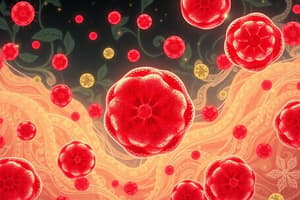Podcast
Questions and Answers
¿Qué factor activa la proteína C en la vía extrínseca?
¿Qué factor activa la proteína C en la vía extrínseca?
- Factor IX
- Factor VII (correct)
- Factor X
- Factor V
¿Qué es el resultado final de la cascada de coagulación?
¿Qué es el resultado final de la cascada de coagulación?
- La formación de un coágulo sanguíneo (correct)
- La formación de trombina
- La activación del factor X
- La formación de fibrinógeno
¿Cuál es el nombre de la vía que se activa mediante la exposición a colágeno o daño vascular?
¿Cuál es el nombre de la vía que se activa mediante la exposición a colágeno o daño vascular?
- Vía intrínseca (correct)
- Vía extrínseca
- Vía común
- Vía de fibrinólisis
¿Cuál es el papel del factor X en la cascada de coagulación?
¿Cuál es el papel del factor X en la cascada de coagulación?
¿Qué enzima convierte el fibrinógeno en fibrina?
¿Qué enzima convierte el fibrinógeno en fibrina?
¿Cuál es el nombre del proceso que descompone el coágulo sanguíneo una vez que ya no es necesario?
¿Cuál es el nombre del proceso que descompone el coágulo sanguíneo una vez que ya no es necesario?
Flashcards are hidden until you start studying
Study Notes
Coagulation Cascade
Overview
- The coagulation cascade is a series of complex biochemical reactions that leads to the formation of a blood clot
- It involves the activation of multiple clotting factors, which ultimately results in the formation of fibrin, a protein that forms the clot
Coagulation Pathways
- Extrinsic Pathway
- Initiated by tissue factor (TF) exposure
- Involves factors VII, IX, X, and V
- Activates factor X, which leads to the formation of thrombin
- Intrinsic Pathway
- Initiated by collagen exposure or blood vessel damage
- Involves factors XII, XI, IX, and VIII
- Activates factor X, which leads to the formation of thrombin
- Common Pathway
- Shared by both extrinsic and intrinsic pathways
- Involves factors X, V, and II (prothrombin)
- Results in the formation of thrombin, which converts fibrinogen to fibrin
Coagulation Factors
- Factor VII: Activates factor X in the extrinsic pathway
- Factor IX: Activates factor X in the intrinsic pathway
- Factor X: Activates prothrombin (II) to form thrombin
- Factor V: Activates prothrombin (II) to form thrombin
- Factor II (Prothrombin): Converted to thrombin by factor X and V
- Thrombin: Converts fibrinogen to fibrin, forming the blood clot
- Fibrinogen: Converted to fibrin by thrombin
Regulation of Coagulation
- Anticoagulant Pathways: Regulate coagulation to prevent excessive clotting
- Involves antithrombin, protein C, and protein S
- Fibrinolysis: Breaks down the blood clot once it is no longer needed
- Involves plasminogen, plasmin, and tissue plasminogen activator (tPA)
Studying That Suits You
Use AI to generate personalized quizzes and flashcards to suit your learning preferences.




